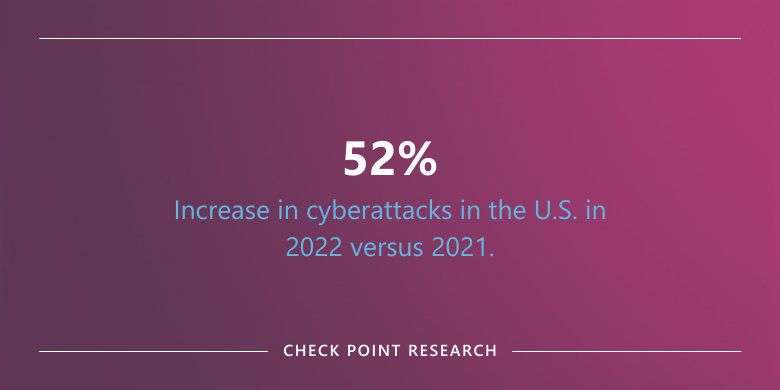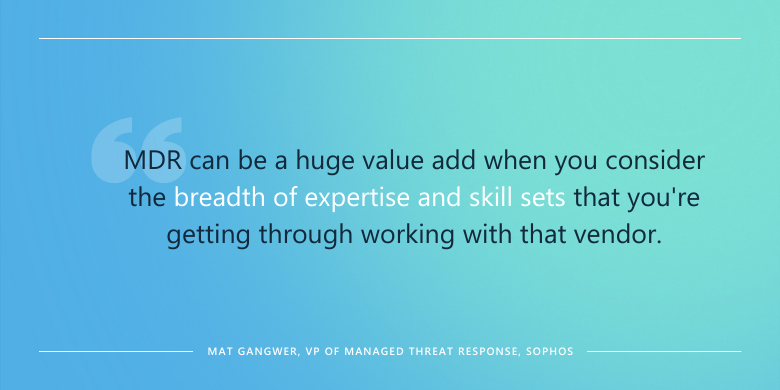Win Over the CFO: Proving the Value of Managed Detection and Response
As an IT leader, you realize cybersecurity’s importance in protecting your company’s assets and customer data. However, when it comes time to allocate a budget for these critical initiatives, convincing your CFO to invest in a managed detection and response (MDR) solution and provider can be challenging.
To get the cybersecurity investments needed for true 24/7 threat detection, investigation, and response capabilities, IT leaders must learn to speak the language of their CFOs and express value clearly. So, how can you convince your CFO that investing in MDR services is the best way to protect your organization? First, let’s explore why MDR is a critical part of your security strategy; then, let’s dive into how to communicate the value of the approach to your CFO with seven essential tips.
Why MDR Is a Critical Part of a Security Strategy
Traditional approaches to cybersecurity are no longer sufficient in dealing with today’s advanced threats. Managed detection and response (MDR) is a proactive approach to cybersecurity that involves continuously monitoring networks, systems, and endpoints and detecting and responding to threats in real time.

MDR services provide organizations with the essential people, processes, and technology needed to detect and stop cyber threats without investing in 24/7 security operations center (SOC) personnel and hefty technology. For example, MDR services can include endpoint detection and response (EDR), identity detection and response (IDR), and extended detection and response (XDR) services, offering complete protection for all at-risk systems.
Additionally, an MDR provider can boost your company’s cyber resilience and reduce organization-wide risk by stopping malicious activity before the damage occurs. The result? End-to-end, comprehensive security that doesn’t break your budget.
How to Prove the Value of MDR to Your CFO
Now that we’ve established why MDR is essential to protecting your organization, you’ll need to guide your organization through treating security as a business issue rather than a technology problem. Here are seven critical tips to help you communicate that value to your CFO to get their buy-in and create a strategic vision for cybersecurity.
.png?width=780&height=390&name=Blog%20Post%20List%20Callout%20Proving%20the%20Value%20of%20Managed%20Detection%20and%20Response%20%20(1).png)
1. Understand Your CFO’s Priorities
The first step in proving MDR’s value is understanding your CFO’s priorities. CFOs are typically focused on protecting the company’s financials and minimizing costs, so you need to present MDR to align with these priorities. Emphasize the cost savings from preventing cyberattacks, protecting the company’s reputation, and avoiding regulatory fines. Explain how MDR services can help minimize costs by reducing the time it takes to detect and respond to cyber threats.
2. Have a Clear Understanding of MDR Capabilities
To make a compelling case for MDR, you must clearly understand these services’ capabilities. MDR solutions provide 24/7 monitoring, threat detection, and incident response capabilities to prevent or mitigate ongoing attacks. By emphasizing the proactive nature of MDR and its automation capabilities, you can show your CFO how these services can help prevent costly data breaches and reduce the likelihood of costly legal settlements.
3. Use Data to Support Your Argument
CFOs are known for being data-driven decision-makers, so you need to use data to support your argument for MDR. Use metrics such as the average cost of a data breach and the time it takes to detect and respond to a threat to show the potential cost savings that can be achieved with MDR. Use real-world examples to illustrate how MDR services can help prevent costly cyber-attacks and minimize the impact of successful attacks.
For example, you must quantify risk and determine your risk appetite. Risk quantification will enable you and your CFO to understand the potential impact of a cyber attack on business outcomes and prioritize security investments accordingly. Risk appetite defines the level of risk your organization is willing to accept to achieve its business objectives. These factors play a crucial role in determining and expressing the value of MDR to your organization.
4. Break Down the Cost Savings of MDR
On top of the savings you’ll see in the case of a breach, MDR is also known as a more cost-effective option than DIY threat detection and response. This is because MDR providers have the knowledge, expertise, and advanced tools needed to detect and respond to threats immediately. Organizations that handle threat detection and response independently must invest in expensive technologies, staff a Security Operations Center, and provide ongoing training to maintain the infrastructure.

In contrast, MDR providers offer comprehensive services at a fraction of the cost. They also stay updated with the latest developments in things like artificial intelligence and cyber insurance, ensuring your defenses evolve as attackers do.
5. Discuss the Risks of Not Investing in MDR
If your CFO is still skeptical about investing in MDR, discussing the potential risks of not investing in these services is essential. Explain how the cost of recovering from a data breach can be crippling to the company’s finances and reputation. Emphasize the importance of preparing for the worst and proactively identifying and neutralizing threats before they become major security incidents that can tarnish the brand’s reputation.
6. Provide Options for Implementation
Finally, providing your CFO with options for implementing MDR services is important. Discuss the various providers and available solutions that fit your needs and budget. Outline the benefits of outsourcing MDR to a third-party provider with expertise and experience in monitoring and responding to cyber threats. Explain why managed security services can be more cost-effective than hiring an internal security team with dedicated MDR responsibilities.
7. Ensure You’re Achieving Your Goals with Relevant KPIs
If you decide to go with MDR, you’ll want to continuously align with your CFO to ensure you’re achieving your goals and the expected business outcomes. For example, ROSI (return on security investment) measurement for MDR services should be done to measure the ability to detect and respond to threats, reduce the risk of a data breach, and ensure compliance. Measuring ROSI can be done through a cost-benefit analysis that calculates the total expected costs of implementing the MDR service compared to the expected net benefits the service will provide.
Key cybersecurity metrics and KPIs should be measured and reported on to measure the success of MDR services. These metrics should be tailored to the organization’s unique needs and objectives. Standard metrics include mean time to detect (MTTD), mean time to respond (MTTR), percentage of false positives, and threat intelligence quality.
Proving the value of MDR to your CFO will require you to understand your CFO’s priorities and express information clearly and succinctly. To do so, you’ll need to understand and explain MDR capabilities, use data and risk appetite to support your argument, break down cost savings, discuss risks, provide options for implementation, and measure ROSI and success using relevant KPIs that align with your objectives.
Partner with ProArch to Develop a Proactive, Cost-Effective Approach to MDR
Take the next step. ProArch’s MDR services cover the detection, containment, and resolution of threats, empowering you to mature your security posture in a way that fits your budget. Learn more about our MDR capabilities here.

Director of Marketing Rebecca leads ProArch's marketing efforts, seamlessly blending technology and storytelling to assist clients in their buying journey. She is dedicated to presenting technological solutions in a compelling manner that drives significant growth for the company. Collaborating closely with sales, engineering, leadership, and HR teams, Rebecca sets the strategic vision for ProArch and ensures alignment across the organization. Her strategic, visionary, and detail-oriented approach shapes ProArch’s brand to be synonymous with reimagining technology to achieve business objectives.

